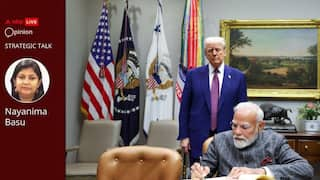Astronomers Discover Black Hole Over 30 Billion Times The Sun's Mass: All About The Ultramassive Black Hole
Researchers have discovered an ultramassive black hole using a technique called gravitational lensing. This is one of the biggest black holes ever discovered.

A team of astronomers has discovered a black hole over 30 billion times the mass of the Sun, using a technique known as gravitational lensing. This is one of the biggest black holes ever discovered, and is known as an ultramassive black hole.
The study describing the findings was published March 29 in the journal Monthly Notices of the Royal Astronomical Society. The team, led by researchers from Durham University in the United Kingdom, used gravitational lensing, and supercomputer simulations on the DiRAC (Distributed Research using Advanced Computing) HPC (High Performance Computing) facility in the UK, to obtain important information about the black hole.
What is gravitational lensing?
Gravitational lensing is a phenomenon in which a foreground galaxy bends the light from a more distant object and magnifies it. The massive celestial body, such as a galaxy cluster, which causes a sufficient curvature of spacetime for the path of light around it to be visibly bent, as if by a lens, is called a gravitational lens.
Time and space are fused together in a quantity known as spacetime, according to Einstein's general theory of relativity, within which massive objects cause spacetime to curve.
Using gravitational lensing and high performance computing, the researchers were able to closely examine how light is bent by a black hole inside a galaxy hundreds of millions of light years from Earth.
Astronomers rarely come across an ultramassive black hole.
What makes the ultramassive black hole unique?
The recently discovered ultramassive black hole is unique because it is the first black hole found using gravitational lensing. As part of the study, the researchers simulated light travelling through the universe hundreds of thousands of times. The simulations represented black holes of different masses, changing the journey of light to Earth.
The researchers included an ultramassive black hole in one of their simulations. They observed that the path taken by the light from the faraway galaxy, in which the black hole is present, to reach Earth matched the path seen in real images captured by NASA's Hubble Space Telescope.
How does gravitational lensing help astronomers?
When the gravitational field of a foreground galaxy appears to bend the light of a background galaxy, a gravitational lens occurs, and we observe the background galaxy more than once.
Similarly, a black hole bends the light from the galaxy inside which it is present, as a result of which the galaxy is magnified, allowing scientists to observe it in enhanced detail.
ALSO READ | Solar Storm Caused By Huge Coronal Hole 20-30 Times Earth's Size Could Hit The Planet On Friday
In a statement released by Durham University, Dr James Nightingale, the lead author on the paper, said the black hole, which is roughly 30 billion times the mass of the Sun, is one of the biggest ever detected, and on the upper limit of how large astronomers believe black holes can theoretically become. Therefore, the discovery of the ultramassive black hole is extremely important.
Nightingale also said that most of the biggest black holes astronomers know about are in an active state, which means that the matter pulled in close to the black hole heats up and releases energy in the form of light, X-rays, and other radiation. The advantage of gravitational lensing is that it allows astronomers to study inactive black holes, something currently not possible in distant galaxies.
Nightingale explained that gravitational lensing could help astronomers detect many more black holes beyond the local universe and reveal how these exotic objects evolved further back in cosmic time.
Significance of the study
The study is important because it opens up the possibility of astronomers discovering far more inactive and ultramassive black holes than previously thought, and exploring how they grew so large.
In 2004, Nightingale's fellow Durham University astronomer, Professor Alastair Edge, noticed a giant arc of a gravitational lens when reviewing the images of a galaxy survey, the statement said. This is when the story of the discovery of this ultramassive black hole began.
Nightingale and his team revisited that finding 19 years later.
According to the researchers, the discovery of the ultramassive black hole could be the first step in enabling a deeper exploration of the mysteries of black holes. They hope that future large-scale telescopes will help astronomers study even more distant black holes.
The authors concluded that the success of the gravitational lensing technique suggests that surveys during the next decade could measure thousands more supermassive black hole masses.






































